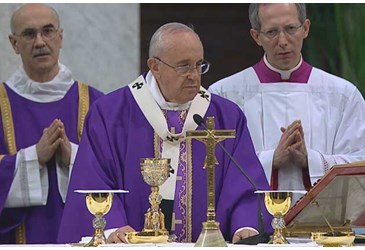On Saturday evening March 7, 2015, Pope Francis celebrated Mass at All Saints Church in Rome in commemoration of the 50th anniversary of the first time Mass was offered in the local vernacular language – (Italian) rather than in Latin. Pope Francis concluded his homily recalling that it was here “in a certain sense,” that Blessed Pope Paul VI , in 1965 “inaugurated the liturgical reform” of the Second Vatican Council, with the celebration of the Mass “in the language of the people.” Pope Francis expressed his hope that this occasion would revive in everyone a great “love for the house of God.” In 1963 the bishops of the Second Vatican Council decided that at least part of the liturgy should be in the language of the people. They gave the local bishops the responsibility to decide whether, and to what extent, the vernacular language was to be used. Their decrees were then to be confirmed by Rome. The Council’s bishops determined that national groups (conferences) should prepare translations of the Latin texts into the vernacular languages (English, Italian, French, German, Spanish, etc.). Bishops from English speaking countries ( Australia, Canada, England and Wales, India, Ireland, New Zealand, Pakistan, Scotland, South Africa and the United States) working together created one translation group: the International Commission on English in the Liturgy (ICEL). The Philippines became the eleventh ICEL member in 1967, and there were 15 other associated conferences where English was not the predominant language. The ICEL gathered English translators, poets, biblical scholars and others to produce the English texts. It quickly became evident that once begun, vernacular translations had to go the whole way, translating the entire Mass and the other sacraments. The ICEL was guided in their translation work by a 1969 instruction document. It gave translators the freedom to adapt the translation of the Latin text so that its meaning would be clearer in the vernacular and to avoid a literal translation of the Latin. The document said the translation should be written in a language suited “even (to) children and persons of small education”. This was in keeping with a desire on the part of translators to make sacred things accessible to as many people as possible. Although praiseworthy, this desire, taken to extreme lengths, could lead to an oversimplification of sacred texts and fear of falsification. So for example, prior to Vatican II, the Latin response of the people to the priest , “ET cum spiritu tuo, “ which literally means “And with your spirit,” when translated into English became “And also with you.” To be continued…
Sources: News.VA, uscatholic.org, holyfamilyartesia.org, Commonwealmagazine., Catholic.com

